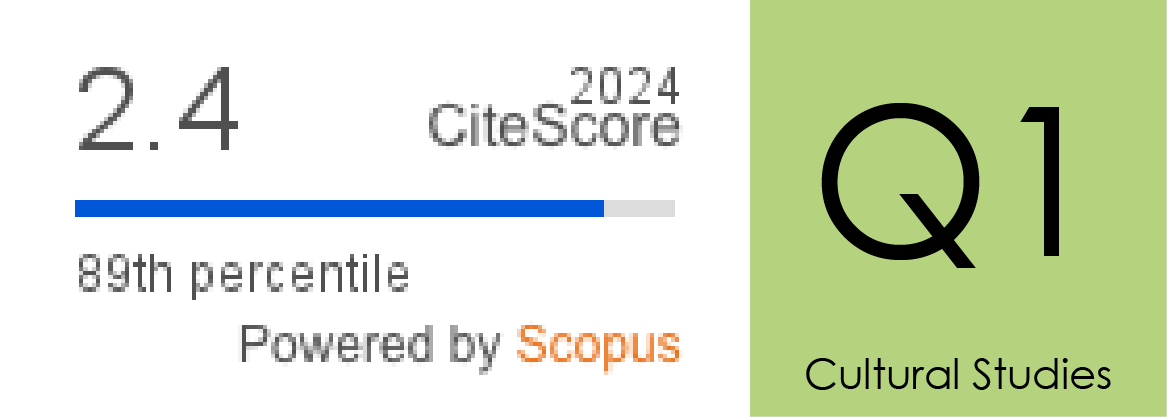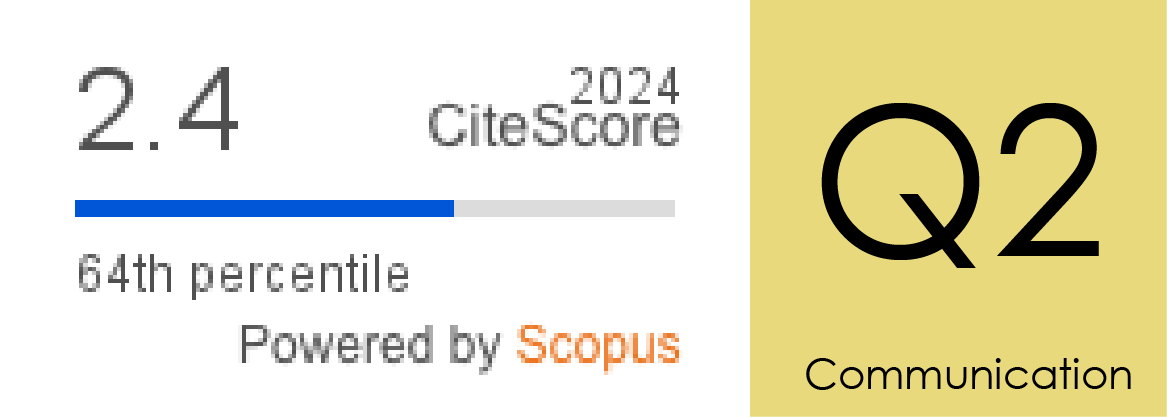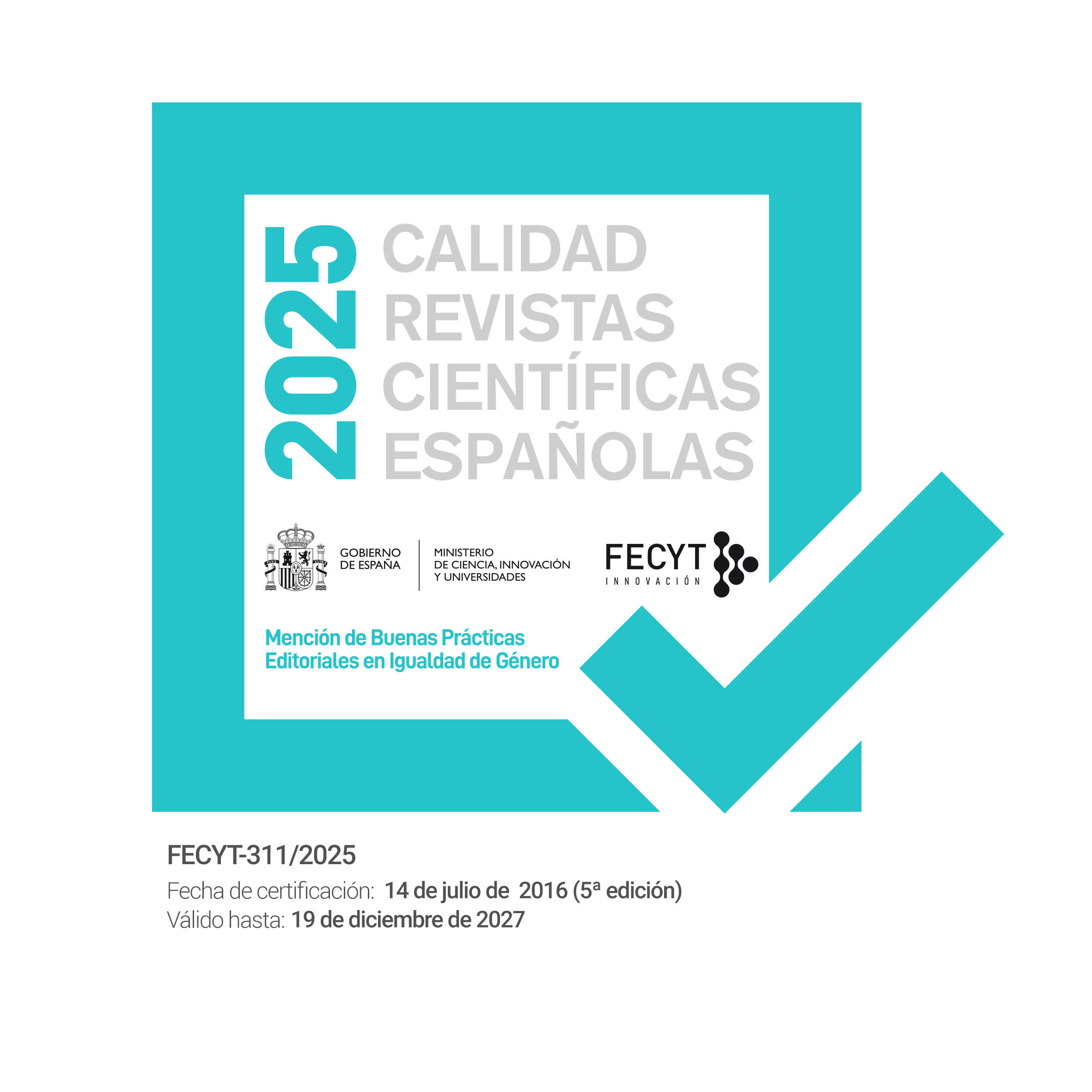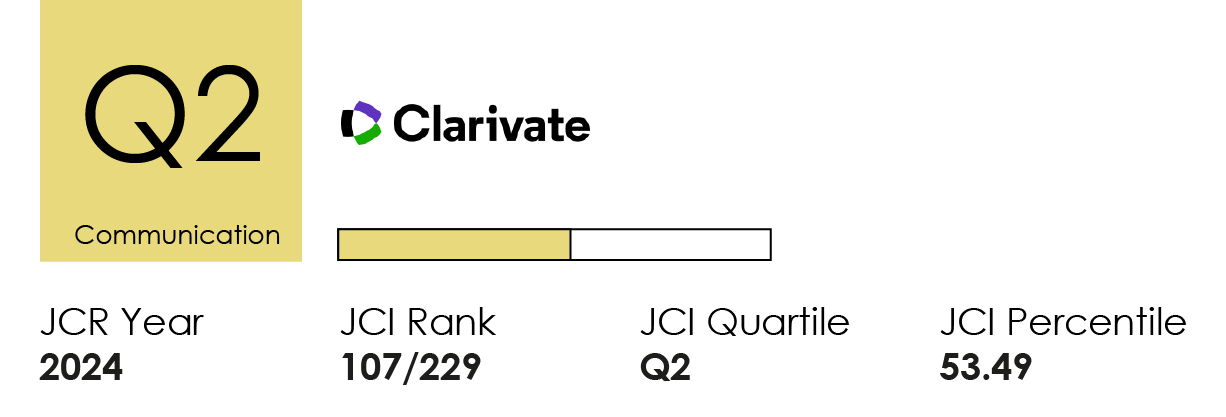Práctica profesional del periodista científico: revisión bibliográfica de las disfunciones derivadas del entorno digital
DOI:
https://doi.org/10.14198/MEDCOM2017.8.2.14Palabras clave:
Ciberperiodismo, Comunicación científica, Periodismo científico, Periodismo colaborativo, Revisión bibliográficaResumen
Internet ha revolucionado el panorama de la comunicación científica. Los periodistas ya no son los únicos actores en la producción y difusión de información dirigida a un público en general, sino que los propios científicos, aprovechando las herramientas que facilita la web (Brossard, 2013), comunican directamente a la audiencia esquivando a los periodistas como mediadores (Peters et al., 2014). Multitud de estudios han abordado estas materias, aunque toda esta investigación se encuentra dispersa y sin un hilo conductor que sitúe en perspectiva las aportaciones realizadas. Por ello, en el presente artículo se realiza una revisión sistemática de 71 trabajos con la que se describe, por un lado, la situación que vive el periodista científico en el entorno online y cómo este canal ha transformado su práctica profesional y, por otro, el nuevo rol de comunicadores públicos que han adquirido algunos científicos. Finalmente, se establece cómo se encuentran las relaciones entre científicos y periodistas en el proceso de comunicación de la Ciencia en la red. El trabajo pone de manifiesto que científicos y periodistas guardan distancias, tienen diferentes apreciaciones sobre cómo debe articularse la comunicación, y utilizan sus propios medios y sus propios códigos para llegar a la misma audiencia.
Citas
Allan, S. (2009a). The future of science journalism. Journalism, 10(3), 280-282. http://dx.doi.org/10.1177/1464884909102570
Allan, S. (2009b). Making science newsworthy: Exploring the conventions of science journalism. En Holliman, R.; Whitelegg, L.; Scanlon, E.; Smidt, S. y Thomas, J. (Eds.), Investigating science communication in the information age: Implications for public engagement and popular media (pp. 149-165). Oxford: University Press.
Allemand, L. (2013). ¿Internet matará o salvará a la prensa científica? La experiencia de la revista francesa ‘La Recherche’. Mètode: Revista de difusión de la Investigación, (80), 71-77. Disponible en https://goo.gl/E33S6y
Alvarado, E. A. (11/03/2013). La investigación y divulgación científica en la era digital. En Programa de formación de Grado Comunicacional Social. Universidad Bolivariana de Venezuela, Maracaibo, Venezuela. Disponible en https://goo.gl/B9GX0P
Bellón Rodríguez, A. (2014). Dos programas y un portal para comunicar la I+D+i en Galicia: Efervesciencia, Soño con Ciencia y GCiencia. Revista de la Asociación Española de Investigadores en Comunicación, 1(2), 58-64. Disponible en https://goo.gl/EUcXF3
Bik, H. M. y Goldstein, M. C. (2013). An introduction to social media for scientists. PLoS biology, 11(4). Disponible en http://dx.doi.org/10.1371/journal.pbio.1001535
Blanchard, A. (2011). Science Blogs in Research and Popularization of Science: Why, how and for whom? En Cockell, J. B.; Darbellay, F. y Waldvogel, F. (Eds.), Common knowledge: The challenge of transdisciplinarity (pp. 219-231). Lausanne: EPFL Press. Disponible en https://goo.gl/31v20n
Brossard, D. (2013). New media landscapes and the science information consumer. Proceedings of the National Academy of Sciences - PNAS, 110 (Supplement 3), 14096-14101. http://dx.doi.org/10.1073/pnas.1212744110
Brown D. D. (17/03/2009). Science blogging: The future of science communication and why you should be a part of it [Blog]. Biochemical Soul. Musings on nature, science, evolution, biology, and education. Disponible en https://goo.gl/pK3ioE
Brumfiel, G. (2009). Science journalism: Supplanting the old media? Nature, 458(7236), 274-277. http://dx.doi.org/10.1038/458274a
Bucchi, M. y Trench, B. (2014). Science communication research, themes and challenges. En Bucchi, M. y Ttrench, B. (Eds.), Routledge Handbook of Public Communication of Science and Technology (pp. 2-11). London: Routledge.
Calloni, M.; Felt, U.; Gorski, A. et al. (2009). Science Communication. En Challenging Futures of Science in Society. Emerging Trends and cutting-edge issues (pp. 50-64). Bruselas: European Commission. Disponible en https://goo.gl/0QZUFf
Cascais, A. F. (2003). Divulgação científica: a mitologia dos resultados. En Sousa, C. M.; Marques, N. P. y Silveira, T. S. (Eds.), A Comunicação Pública da ciencia (pp. 65-77). São Paulo: Cabral Editora e Livraria Universitária. Disponible en https://goo.gl/oi1lW5
Casino, G. (2014). 13. Conflictos y complicidades entre científicos y periodistas. Una visión crítica con propuestas de mejora. Quaderns de la Fundació Dr. Antoni Esteve, (28), 97-103. Disponible en https://goo.gl/BQAJ16
Cazaux, D. (2016). La comunicación pública de la Ciencia y la tecnología en la “Sociedad del Conocimiento”. Razón y Palabra, (65). Disponible en https://goo.gl/8uSnHm
Colson, V. (2011). Science blogs as competing channels for the dissemination of science news. Journalism, 12(7), 889 – 902. http://dx.doi.org/10.1177/1464884911412834
Cullen, T. A. (03/07/2013). Online health information: shortcomings and challenges. En Global Networks-Global Divides: Bridging New and Traditional Communication Changes. Australia and New Zealand Communication Association (ANZCA), Fremantle, Australia. Disponible en https://goo.gl/kxPYeg
Elías, C. (2008). Fundamentos de periodismo científico y divulgación mediática. Alianza Editorial.
Darling, E. S.; Shiffman, D.; Côté, I. M. y Drew, J. A. (2013). The role of Twitter in the life cycle of a scientific publication. PeerJ PrePrints. https://doi.org/10.7287/peerj.preprints.16v1
Davies, B. J. y Glasser, N. F. (2014). Analysis of www.AntarcticGlaciers.org as a tool for online science communication. Journal of Glaciology, 60(220), 399-406. http://dx.doi.org/10.3189/2014JOG13J194
De Semir, V. (2010). Science Communication & Science Journalism. Madrid: Media for Science Forum.
VV.AA. (2003). Declaración de Berlín sobre acceso abierto. Disponible en https://goo.gl/Vs2RCW
Dunwoody, S. (2014). Science journalism: prospects in the digital age. En Bucchi, M. y Trench, B. (Eds.). Routledge Handbook of Public Communication of Science and Technology (pp. 27-39). Routledge.
Fahy, D. y Nisbet, M. C. (2011). The science journalist online: Shifting roles and emerging practices. Journalism, 12(7), 778-793. http://dx.doi.org/10.1177/1464884911412697
Fausto, S.; Machado, F. A.; Bento, L. F. J.; Iamarino, A.; Nahas, T. R. y Munger, D. S. (2012). Research blogging: Indexing and registering the change in science 2.0. PloS one, 7(12), 1-10. http://dx.doi.org/10.1371/journal.pone.0124184
Fernández de Lis, P. (2013). Ciencia y periodismo en la red. Quaderns de la Fundació Dr. Antoni Esteve, (28), 15-19. Disponible en https://goo.gl/ktASOs
Fleischman, J. y Szalinski, C. (2014). So you want to be a science writer. Molecular biology of the cell, 25(13), 1938-1941. https://dx.doi.org/10.1091/mbc.E14-04-0857
Galligan, F. y Dyas-Correia, S. (2013). Altmetrics: Rethinking the way we measure. Serials Review, 39(1), 56-61. http://dx.doi.org/10.1016/j.serrev.2013.01.003
García Álvarez de Toledo, J. y Fernández Sánchez, R. (2011). Difusión y divulgación científica en internet. Gobierno del Principado de Asturias. Disponible en https://goo.gl/E8M4y6
Gerber, A. (2014). Science Caught Flat-Footed: How Academia Struggles with Open Science Communication. En Bartling, S. y Friesike, S. (Eds.), Opening Science (pp. 73-80). Springer International Publishing. http://dx.doi.org/10.1007/978-3-319-00026-8_4
Gomes, I. M. A. M. y Flores, N. M. (2012). Um olhar bakhtiniano sobre os blogs de ciência. Macabea – Revista Electrônica do Netlli, 1(2), 391-407. Disponible en https://goo.gl/apP7ZL
González-Pedraz, C. y Campos-Domínguez, E. (2015). El periodista científico en la blogosfera de Ciencia: un actor privilegiado en un entorno digital abierto. Panace@: Revista de Medicina, Lenguaje y Traducción, 16(42), 158-164. Disponible en https://goo.gl/i8xInE
Gramling, C. (2008). Science bloggers question their role. Geotimes, 53(6).
Granado, A. (2011). Slaves to journals, serfs to the web: The use of the internet in newsgathering among European science journalists. Journalism, 12(7), 794-813. http://dx.doi.org/10.1177/1464884911412702
Gregory, J. (2009). Scientists communicating. En Holliman, R.; Thomas, J.; Smidt, S. et al. (Eds.), Practising science communication in the information age: Theorising professional practices (pp. 3-18). Oxford: University Press.
Griffiths, M. (2007). Talking physics in the social web. Physics world, 29(1), 24-28. Disponible en https://goo.gl/B6gmlH
Holliman, R. (2007). Reporting environmental news: newspapers in the digital age. Frontiers in Ecology and the Environment, 5(5), 277-278. http://dx.doi.org/10.1890/1540-9295(2007)5[277:RENNIT]2.0.CO;2
Holliman, R. (2010). From analogue to digital scholarship: implications for science communication researchers. JCOM, 9(3). Disponible en https://goo.gl/WFg14Z
Holliman. R. (2011a). Telling science stories in an evolving digital media ecosystem: from communication to conversation and confrontation. JCOM, 10(4). Disponible en https://goo.gl/UwxCLw
Holliman, R. (2011b). How blogs, Twitter and other social media tools are changing conversations about scientific research. Earth Magazine. Disponible en https://goo.gl/TpCYHj
Horning Priest, S. (2009). Reinterpreting the audiences for media messages about science. En Holliman, R.; Thomas, J.; Smidt, S. et al. (Eds.), Investigating science communication in the information age: Implications for public engagement and popular media (pp. 223-236). Oxford: University Press.
Jáuregui, P. (2013). Periodismo científico: el desafío de compartir «información asombrosa». Quaderns de la Fundació Dr. Antoni Esteve, (28), 9-14. Disponible en https://goo.gl/BFcWIq
Lederbogen, U. (2004). When Science goes public on the web: An analysis of the online PR strategies of German Universities and Research Organizations. Scientific Knowledge and Cultural Diversity, 267-275. Disponible en https://goo.gl/UCtW48
Lemos, A. (2009). Nova esfera conversacional. En Künsch, A.; Silveira, S.A. et al. (Eds.), Esfera pública, redes e jornalismo (pp. 9-30). Rio de Janeiro: E-Papers. Disponible en https://goo.gl/rNNAzG
Marín-Murillo, F. y Armentia-Vizuete, J. I. (2002). El periodismo científico en los diarios digitales del Estado español. Mediatika: cuadernos de medios de comunicación, (8), 157-178. Disponible en https://goo.gl/Y77aVI
Mauranen, A. (2013). Hybridism, Edutainment, and doubt: Science blogging finding its feet. Nordic Journal of English Studies, 13(1), 7-36. Disponible en https://goo.gl/Y3BJRv
McCombs, M. (1997). Building consensus: The news media's agenda-setting roles. Political Communication, 14(4), 433-443. http://dx.doi.org/10.1080/105846097199236
McFedries, P. (2012). Measuring the impact of altmetrics [Technically Speaking]. IEEE Spectrum, 8(49), 28. Disponible en https://goo.gl/htDtJl
Minol, K.; Spelsberg, G.; Schulte, E. y Morris, N. (2007). Portals, blogs and co.: the role of the Internet as a medium of science communication. Biotechnology journal, 2(9), 1129-1140. http://dx.doi.org/10.1002/biot.200700163
Montgomery, S. L. (2009). Science and the online world: realities and issues for discussion. En Holliman, R.; Thomas, J.; Smidt, S. et al. (Eds.), Practising science communication in the information age: Theorising professional practices (pp. 83-97). Oxford: University Press.
Murcott, T. H. y Williams, A. (2013). The challenges for science journalism in the UK. Progress in Physical Geography, 37(2), 152-160. http://dx.doi.org/10.1177/0309133312471285
Nature. (2009). Filling the void, Editorial. Nature, 458, 260. http://dx.doi.org/10.1038/458260a
Oliveira Fagundes, V. (05/05/2014). Science blogs: communication, participation and public engagement. En 13º Congreso Internacional sobre Comunicación Pública de la Ciencia y la Tecnología (PCST), Salvador, Brasil. Disponible en https://goo.gl/Fwbv20
Osterrieder, A. (2013). The value and use of social media as communication tool in the plant sciences. Plant methods, 9(1), 26. http://dx.doi.org/10.1186/1746-4811-9-26
Pereira, I. C. L. (2012). Ciência 2.0: Comunicar ciência na era digital – da experiência à reflexão. Universidade do Porto. Disponible en https://goo.gl/LvYXCJ
Peters, H. P. (2013). Gap between science and media revisited: Scientists as public communicators. Proceedings of the National Academy of Sciences, 110(Supplement 3), 14102-14109. http://dx.doi.org/10.1073/pnas.1212745110
Peters, H. P.; Dunwoody, S.; Allgaier, J.; Lo, Y. Y. y Brossard, D. (2014). Public communication of science 2.0. EMBO reports, 15(7), 749-753. http://dx.doi.org/10.15252/embr.201438979
Peterson, I. (2001). Touring the scientific web. Science Communication, 22(3), 246-255. http://dx.doi.org/10.1177/1075547001022003002
Picardi, I. y Regina, S. (2008). Sience via podcast. JCOM, 7(2). Disponible en https://goo.gl/Qca0Ra
Pont Sorribes, C.; Cortiñas Rovira, S. y Di Bonito, I. (2013). Challenges and opportunities for science journalists in adopting new technologies: the case of Spain. JCOM, 12(03). Disponible en https://goo.gl/tzTCVj
Porto, C. y Almeida, D. (2009). Divulgação científica independente na Internet como fomentadora de uma cultura científica no Brasil: estudo inicial em alguns Blogs que tratam de ciência. En Magalhães, C. (Ed.), Difusão e cultura científica: alguns recortes (pp. 93- 112). Salvador, Brasil: SciELO-EDUFBA. Disponible en https://goo.gl/Dcy4gf
Porto, C. y Palacios, M. S. (2012). O lugar eo peso da autopublicação na internet ea cultura científica no Brasil. Revista Educação e Cultura Contemporânea, 9(18), 53-74. Disponible en https://goo.gl/G5ABYl
Puschmann, C. (2014). (Micro) Blogging Science? Notes on Potentials and Constraints of New Forms of Scholarly Communication. En Friesike, S. y Bartling, S. (Eds.), Opening Science, (pp. 89-106). New York, NY: Springer International Publishing. http://dx.doi.org/10.1007/978-3-319-00026-8_6
Revuelta, G. (1999). Relaciones entre científicos y periodistas. Alambique: Didáctica de las Ciencias Experimentales, 6(21), 27-34. Disponible en https://goo.gl/LUimB3
Ribas, C. (2012). La divulgación y la comunicación de la Ciencia, en la encrucijada. SEBBM, 173, 10-12. Disponible en https://goo.gl/2jJRjN
Seabra, D. F. D. S. (2012). O envolvimento dos jovens em conteúdos de ciência online. Universidade do Porto. Disponible en https://goo.gl/KqAfnJ
Schäfer, M. (2011). Science journalism and fact checking. JCOM, 10(4). Disponible en https://goo.gl/KRXziC
Shanahan, M. C. (2010). Changing the meaning of peer-to-peer? Exploring online comment spaces as sites of negotiated expertise. JCOM, 9(1). Disponible en https://goo.gl/hiEehd
Thorsen, E. (2013). Blogging on the ice: Connecting audiences with climate-change sciences. International Journal of Media & Cultural Politics, 9(1), 87-101. https://doi.org/10.1386/macp.9.1.87_1
Trench, B. (2007). How the Internet changed science journalism. En Bauer, M. y Bucchi, M. (Eds.), Journalism, Science and Society: Science Communication Between News and Public Relations (pp. 133-139). Routledge. Disponible en https://goo.gl/4kc9xO
Trench, B. (2009). Science reporting in the electronic embrace of the Internet. En Holliman, R.; Whitelegg, L.; Scanlon, E. et al. (Eds.), Investigating science communication in the information age: Implications for public engagement and popular media (pp. 166-180). Oxford: University Press.
Trumbo, C. W.; Sprecker, K. J.; Dumlao, R. J.; Yun, G. W. y Duke, S. (2001). Use of e-mail and the web by science writers. Science Communication, 22(4), 347-378. http://dx.doi.org/10.1177/1075547001022004001
Véiliverronen, E. (1993). Science and the media: changing relations. Science studies, 6(2), 23-34. Disponible en https://goo.gl/jyfHbw
Vera Carrasco, O. (2009). Cómo escribir artículos de revisión. Revista Médica La Paz, 15(1), 63-69. Disponible en https://goo.gl/hPZTgB
Waldrop, M. M. (2008). Science 2.0: Great New Tool, or Great Risk? Wikis, blogs and other collaborative web technologies could usher in a new era of science. Or not. Scientific American. Disponible en https://goo.gl/Tpl63G
Wilcox, C. (2012). Guest editorial: It's time to e-volve: Taking responsibility for science communication in a digital age. The Biological Bulletin, 222(2), 85-87. http://dx.doi.org/10.1086/BBLv222n2p85
Ziman, J. (1979). Conhecimento público. Belo Horizonte: Editora Itatiaia.
Descargas
Estadísticas
Publicado
Cómo citar
Número
Sección
Licencia
Derechos de autor 2017 Cristina González-Pedraz, Eva Campos-Domínguez

Esta obra está bajo una licencia internacional Creative Commons Atribución-CompartirIgual 4.0.
Los autores y autoras que publican en esta revista están de acuerdo con los siguientes términos:
1 Derechos de autor. Los autores y autoras conservan sus derechos de autor, aunque ceden a la revista de forma no exclusiva los derechos de explotación (reproducción, distribución, comunicación pública y transformación) y garantizan a esta el derecho de primera publicación de su trabajo, el cual estará simultáneamente sujeto a la licencia indicada en punto 2. Los autores pueden establecer otros acuerdos adicionales para la distribución no exclusiva de la versión de la obra publicada en la revista, siempre que exista un reconocimiento de su publicación inicial en esta revista.
© Los autores.
2 Licencia. Los trabajos se publican en la revista sujetos a la licencia de Reconocimiento 4.0 Internacional de Creative Commons (CC BY 4.0); los términos se pueden consultar en https://creativecommons.org/licenses/by/4.0/
Esta licencia permite a terceros compartir (copiar y redistribuir el material en cualquier medio o formato) y adaptar (remezclar, transformar y crear a partir del material para cualquier finalidad, incluso comercial), siempre que se reconozca la autoría y la primera publicación en esta revista (Revista Mediterránea de Comunicación (RMC) / Mediterranean Journal of Communication (MJC), Universidad de Alicante, DOI de la obra), se proporcione un enlace a la licencia y se indique si se han realizado cambios en la obra.
3 Política de autoarchivo. Se recomienda a los autores que difundan sus trabajos a través de Internet para favorecer una circulación y difusión más rápidas y, con ello, un posible aumento en la citación y alcance entre la comunidad científica y académica, en las siguientes condiciones:
No se permite a los autores depositar en un repositorio institucional o temático, página web propia, etc., las versiones preprint (versión antes de ser evaluada) o postprint (versión evaluada y aceptada para su publicación) de sus trabajos antes de su publicación, pero sí el artículo final publicado (versión del editor).













